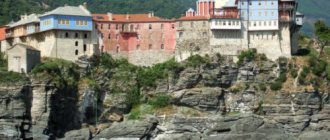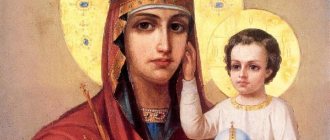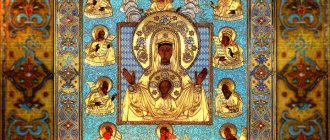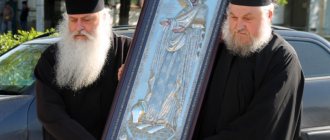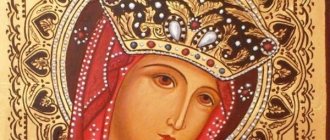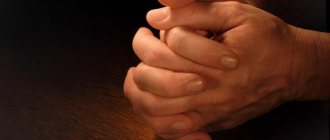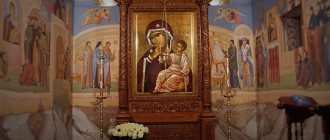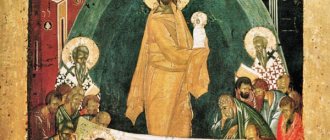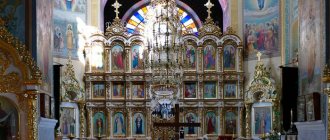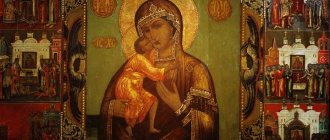"Save me, God!".
Thank you for visiting our website, before you start studying the information, please subscribe to our Orthodox community on Instagram, Lord, Save and Preserve † - https://www.instagram.com/spasi.gospodi/. The community has more than 60,000 subscribers. There are many of us like-minded people and we are growing quickly, we post prayers, sayings of saints, prayer requests, and timely post useful information about holidays and Orthodox events... Subscribe. Guardian Angel to you!
The joy of motherhood is quite often accompanied by a number of problems and difficulties that a young mother faces. The original calling of a woman was to give birth and feed her child. The intercessor of the mother-nurse is the Image of the Mother of God “Mammal.”
The Mammal Icon of the Mother of God is an image of a woman breastfeeding a baby. Not a single icon, except this one, reveals the sacred sacrament - a mother feeding her child - the Mother of God feeding her son, His Holiness Jesus Christ. The greatest sacrament in the world is feeding a child, for which every mother is ready to do anything in order to realize the ability given by God to feed her baby.
The most ancient image of the Mother of God
“Mammal” is one of the oldest images in world Christian culture. Its first images - frescoes - were found in the 2nd century in one of the catacomb burials in Rome.
Useful materials
Interesting fact
The cult of the Mother of God-Mammal became especially widespread in Egypt. An image of the Mother of God nursing Jesus is preserved on the walls of the Coptic monastery in Saqqara. Historians attribute it to the V-VII centuries.
Researchers also believe that it was Coptic images that became the prototype for copying the plot by Western icon painters.
Painting by Ambrogio Lorenzetti
In the first paintings of the Western Middle Ages, the forms of the nursing Virgin Mary are noticeably flattened. Such an unrealistic style of writing is an attempt to combine the features of the divine and earthly in her image.
A different approach to depicting the plot was demonstrated by the Italian painter Ambrogio Lorenzetti. The perspective, volume and psychologism of the artist’s creations, including religious themes, were far ahead of his time.
The Mammal Madonna, written by him between 1325 and 1348, was no exception. The secular manner of writing makes the Virgin and Child look like ordinary people, as if they had emerged from the human flow of the Italian medieval streets.
However, in subsequent centuries, the cult of the Virgin Mary gradually faded away in the West. This was caused by the Catholic Church's ban on nudity.
Different traditions
It must be said that the significance of the icon of the Mother of God of Mammoth was noted in a special way not only in Orthodoxy; Catholicism also actively used this topic. Even if over time in Orthodoxy this composition became a mostly atypical and “highly specialized” version, in Catholicism the Madonna and Child became a generally accepted image.
As you know, in Catholicism, images are more artistic in nature; they are actually paintings, but with a religious theme. Therefore, the artists here had the opportunity to use many impressive techniques. In particular, in the theme of the Mammal Mother of God icon, you can work with the fine details of Mary’s face, emphasizing various emotions and creating a beautiful image of immaculate motherhood.
Many artists, such as Leonardo da Vinci, created similar images. However, after the 16th century, this artistic tradition disappeared, as Catholics prohibited the painting of nudes, and the image of the Virgin Mary nursing her child was also prohibited.
What does the face of the Virgin Mary help with?
Since ancient times, the Mammal Mother has been revered in Rus', turning to her for help and protection. Those for whom the birth of a child is a long-awaited miracle turn to her with special reverence and hope.
- Any pregnant woman who wants to feed her child with mother's milk appeals to the Heavenly Intercessor.
- They resort to the image of the Mother of God to heal the illnesses of children.
- At the most crucial moment, a prayer to the “Mammal” can help women in labor easily relieve themselves of their burden.
- For diseases of the mammary glands, for gynecology.
- When faced with family problems and difficulties, many people turn to the Mother of God asking for calm and understanding.
The Mother of God is our Heavenly Intercessor
What does the Mother of God icon “Mammal” mean? The Virgin Mary is revered by the Orthodox as the greatest of saints. After all, She immaculately, with the participation of the Holy Spirit, conceived and gave birth to the Son of God, the Savior of all mankind - Jesus Christ. She also spent the longest time next to the God-Man, saturated with His Word and grace.
Icon of the Mother of God “Mammal”
Saint Theophan the Recluse teaches:
“The human nature of God was taken from the Ever-Virgin Mary through the influx of the Holy Spirit and the overshadowing of the power of the Most High” (“Letters”).
Saint Theophan adds that even the highest ranks of angels did not have such a close and significant participation in our salvation as the Mother of God. That is why Her intercession for people before God is so strong. Being the Mother of the Heavenly King, the Virgin Mary is revered by the Church as the Queen of Heaven.
Orthodox Christians turn to the Mother of God every day in their prayers. There are many different icons of the Blessed Virgin Mary. Some of them are completely different from each other. However, they all serve as a “window” into the spiritual world. They help us, through the holy image, to lift our hearts to the Queen of Heaven Herself. She will hear and help everyone who turns to Her sincerely and with repentance. Venerable Nicodemus the Holy Mountain instructs:
“When you see the icon of the Most Holy Theotokos, turn your heart to Her, the Queen of Heaven. Thank Her for appearing so ready to submit to the will of God. For giving birth, feeding and raising the Savior of the world. And that in our invisible warfare Her intercession to help us never fails” (“Creations”).
History of Galactotrophus
In Eastern Christian culture, the first images of the Mammal as lists of Western subjects appear in the 14th century in Greece and the Balkans.
There is also an Orthodox version of the origin of the icon, based on legends.
According to legend, the place of glorification of the revered icon was the male monastic monastery of Savva the Sanctified, which was located 18 kilometers from Jerusalem.
The Monk Savva had a special gift of foresight. He predicted that several centuries later a wanderer of high rank and bearing the same name should arrive at the monastery.
He was supposed to bring the “Mammal” icon as a gift. After 6 centuries, the prophecy comes true. The monastery is visited by a pilgrim - Savva Archbishop of Serbia.
The legend says that during prayer at the tomb of his heavenly patron Savva the Sanctified, a sign was given from above. The monks, remembering the founder’s prophecy, gave him the Mammal as a gift.
He transported the icon given to him to one of the Athos cathedrals - the Hilendar monastery. The revered icon is kept there to this day.
Reading rules
Since the text of the akathist written to the “Mammal” icon is quite long, the Orthodox Church does not prohibit reading it from a piece of paper. Before starting a prayer appeal to the Mother of God, you should definitely purchase an icon and read the akathist while looking at it. In the last stages of bearing a baby, it is difficult for a pregnant girl to stand on her feet for a long time, so in this case it is allowed to read the prayer while sitting.
Also, the akathist “To the Mammal” can be read by close relatives of a pregnant woman if the expectant mother is not feeling well and she cannot do it on her own. It is recommended to start reading the text even before the baby is born.
If, after turning to the Mother of God, the birth was successful and the mother has enough milk to feed her baby, it is necessary to visit an Orthodox church and thank the intercessor by ordering a special prayer service from the priest in honor of the Queen of Heaven.
Meaning of the icon
In the iconography of the Mother of God, there are three fixed canons of Her image that came from Byzantium - “The Sign”, “Hodegetria” and “Tenderness”.
Each of them contains its own semantic dominant, a key property of the image, one of the aspects of Her ministry, which are conveyed through many details: composition, gestures of the Mother of God with the Child, the color of the robe.
In the iconography of “Tenderness,” the images of the Virgin Mary and the baby evoke special feelings. All of them seem to be permeated with the light of love, tender affection. But, being part of this iconographic style, “Mammal” also has features unique to it.
A distinctive feature of the icon of the Mother of God-Mammal is that here She is depicted as a mother feeding her Child.
The Son Jesus tasting the life-giving milk of the Mother of God is a rather rare subject in the icon painting works of Russian masters. Behind its naturalistic appearance is a deep philosophical narrative.
According to the canons, on the icons the Mother of God is depicted in traditional clothes, the color palette of which is deeply symbolic. The blue color of the tunic with varying degrees of gradation is virgin purity.
Maforium and plat - outer clothing - are traditionally depicted in a dark crimson color, which, as is known, contains shades of blue and red. The combination of these colors on the clothes of the Mother of God symbolizes the union of Her virgin purity with the flesh and blood of the Son of God.
Such a play of colors, emphasizing the multilayered nature of the robe, is a kind of color metaphor that reveals the depth of Her image, when read, the theological subtext also consistently unfolds.
The combination of the sacred and everyday in the plot is a way to express the idea of the unity of the earthly and heavenly, of the desire to contain the Divine principle in the human soul, uniting them into a single hypostasis.
It is no coincidence that their faces are facing each other, and their halos often touch. The image of the Mother of God is multifaceted; it expresses various states of the soul: from the highest spiritual to the non-sacred, earthly.
Veneration in Russia
In Rus', this icon and copies from it have been revered since ancient times. But meeting him in churches is very rare.
The first image of the icon, which is a canon, is kept in the church of the Hilandar Monastery on Mount Athos.
Its acquisition by the Slavs not far from Minsk, according to church tradition, dates back to 1650.
Where the revered image first appeared, the residents built a temple in honor of the Dormition of the Blessed Virgin Mary. Legend says that the icon of the Krestogorsk Mammal helped people find salvation during the Russian-Swedish War.
Church chronicles tell of other miracles in cities and villages. Everywhere where icons of the Mammal appeared, people turned to her with their prayers, and the revered image did not abandon the suffering.
The famous list was brought to Russia in the 19th century by Schemamonk Ignatius from the Ilinsky monastery. Already in our days, the miraculous image of the Most Pure Virgin Mammal was found in the Holy Trinity Cathedral of Armavir , where it is kept to this day next to what was created in the icon-painting workshop.
Where is it located in Moscow
The holy image of the Mammal, famous for its miraculous properties, is in the Moscow Elokhov Epiphany Cathedral . It is located at: Moscow, st. Spartakovskaya, 15. Lists of the venerated Athonite Mammal were donated by the Monk Gabriel of Athonite.
Prayers to the icon of the Mother of God-Mammal have healing powers. After all, just as she nursed her Son, the Mother of God feeds our souls with the “pure verbal milk” of the Word of God (1 Peter 2.2).
Where is
The most revered image is located on Mount Athos in the north of Eastern Greece, in the Church of Karelian Kelia. In the capital of Russian cities - Moscow, this face can be found in the Epiphany Cathedral and in the Church of St. Nicholas, and on the territory of Ukraine, in the beautiful city of Odessa, a list of the holy face is kept in the Holy Dormition Monastery. Next to the image in the Odessa church, there is a rare shrine - part of the most holy robe of Jesus Christ.
God bless you!
The best article for you, go to: The Life of St. John Kushchnik
You will also be interested in watching a film about this miraculous icon:
Prayer
We magnify You, Most Holy Virgin, Mammal of our Savior, and honor Your holy image, from whom You have ever given us the grace of healing.
Accept, Lady Theotokos, the tearful prayers of Your servants who flow to You. We see You in the holy icon, carrying in your arms and feeding with milk Your Son and our God, the Lord Jesus Christ. Even if you gave birth to Him painlessly, even though the mother weighed the sorrow and infirmity of the sons and daughters of human beings. With the same warmth falling upon Thy whole-bearing image and tenderly kissing this, we pray to Thee, all-merciful Lady: we, sinners, condemned to give birth to sickness and nourish our children in sorrow, mercifully spare and compassionately intercede, but our babies, who also gave birth to them, deliver from serious illness and bitter sorrow. Grant them health and prosperity, and their nourishment will increase in strength, and those who feed them will be filled with joy and consolation, for even now, through Your intercession from the mouth of a baby and those who piss, the Lord will bring His praise. O Mother of the Son of God! Have mercy on the Mother of the sons of men and on Your weak people: quickly heal the illnesses that befall us, quench the sorrows and sorrows that are upon us, and do not despise the tears and sighings of Your servants. Hear us on the day of sorrow who fall before Your icon, and on the day of joy and deliverance receive the grateful praise of our hearts. Offer our prayers to the throne of Your Son and our God, that He may be merciful to our sin and weakness and add His mercy to those who know His name, so that we and our children may glorify You, the merciful Intercessor and true hope our kind, forever and ever. Amen.
Ikos 7
The new saint Savva, the saint of the Serbian land, came to the ancient monastery and received the holy icon according to his words and brought it to Mount Athos to the Hilandar monastery, and all its inhabitants joyfully cried out to the Lady of the world:
Rejoice, you who always provide for us sinners.
Rejoice, you who forget us sinners.
Rejoice, renewing Your mercy a thousandfold in Your holy, miraculous icons.
Rejoice, now pouring out a new sign of Your bounties.
Rejoice, having loved those who love and honor Thee dearly.
Rejoice, you who never put those who pray to shame.
Rejoice, Virgin Mammal Mother of God, who always nourishes us with Your mercy.
